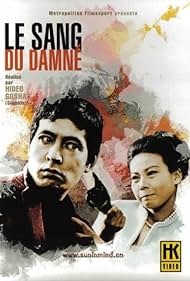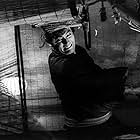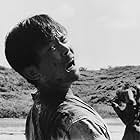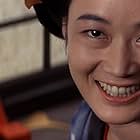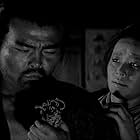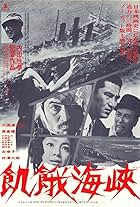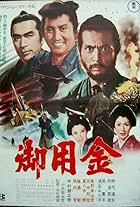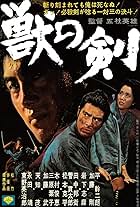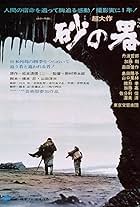Aggiungi una trama nella tua linguaFresh out of prison, a broken man reluctantly takes a job to kill three men, but changes his mind when some gangsters target the same men. He then tries to find out why the men are being tar... Leggi tuttoFresh out of prison, a broken man reluctantly takes a job to kill three men, but changes his mind when some gangsters target the same men. He then tries to find out why the men are being targeted in the first place.Fresh out of prison, a broken man reluctantly takes a job to kill three men, but changes his mind when some gangsters target the same men. He then tries to find out why the men are being targeted in the first place.
Foto
Trama
Recensione in evidenza
GOHIKI NO SHINSHI bears all the hallmarks of film noir: a labyrinthine plot involving crime and betrayal, gritty urban settings, expressionistic black-and-white camera-work, and a hero seeking redemption for his sins. The film begins with Oida (Tatsuya Nakadai) in prison for killing a man and his daughter in a car accident. He didn't mean to do it, but the fact that he was distracted by an argument with his bar-hostess girlfriend, whom he was about to dump to marry his boss's daughter, increases his sense of guilt and our sense that he might be a selfish, opportunistic man. A few days before he is to be released, Oida attracts the attention of another prisoner, Sengoku, when he risks his life to help capture a knife-wielding inmate. Learning Oida's story, and that he has no life to return to (he lost his job and fiancée because of the accident, and has no family), Sengoku makes him a proposition. The payoff is big; no questions are allowed. He is to assassinate three men for a share of 30 million yen.
Oida drifts into accepting the deal but soon has second thoughts. He meets the first man, Motoki, and comes close to pushing him off a dock while he's drunk, but can't quite do it. When he leaves him briefly, Motoki is killed by two mysterious, trench-coated gangsters. Oida tracks down the other two men on his list, not to kill them but to warn them that their lives are in danger. He also becomes the reluctant guardian of Motoki's orphaned daughter, the adorable pigtailed Tomoe. He obsessively tries to uncover the secret behind the strange colliding vendettas: why do both Sengoku and the gangsters want the three men dead, and what happened two years ago at a train station? (We have some idea, having seen a heist, stylishly shot in negative, over the credits). Each of the three men tells a story about how he slipped into crime: one is a former cop who fell in love with a criminal's wife, another a boxer who had his arm broken after he refused to throw a fight. Everyone is sad and desperate, including Sengoku's girlfriend, a bar hostess who says, "We're all prisoners on death row," and the widow of the man Oida killed, whom he meets backstage in a cabaret, still burning with hatred for him.
This is not Ozu's Japan. "Seamy underbelly" hardly does justice to the film's settings: grimy docks, industrial warehouses, junkyards, prison yards, deserted amusement parks, alleys, strip clubs and cheap bars where two hostesses have a vicious cat fight in the bathroom. Amid this squalor the elegant, beautiful Nakadai moves like a fallen angel, spellbound by melancholy and remorse. Slowly he comes to life as he finds a purpose in protecting Tomoe, who follows him like a lost duckling, calling him "Oji-san" (uncle). He lets Sengoku think he killed the men as instructed, planning a double-cross of his own. When Tomoe is kidnapped, fate provides him with a chance to redeem himselfbut it won't be easy, since the newly-released Sengoku cares as much about money as Oida cares about his buying back his soul.
Hideo Gosha was a master of genre, making a slew of chambara (swordplay) and yakuza (gangster) films. He's principally a stylist, and at times the style overtakes the substance and gets a bit rococo (he loves startling cuts and long-drawn-out fights.) Nakadai said that the director often cared more about the images than the story, but called him an "impassioned" filmmaker. GOHIKI NO SHINSHI is a fairly standard thriller, impeccably entertaining, and the combination of powerful acting and authentic locations give it a special weight. What lingers most is the weary, lyrical evocation of a world full of hurt, where moments of gentleness are rare and precious. The only flaw is a musical score than tends towards cheesy cocktail jazz, nudging some scenes close to sentimentality. And what was it with the harpsichord in 1960s Japanese films?
NOTE: GOHIKI NO SHINSHI is a truly untranslatable title: it means "Five Gentlemen," but "hiki" is the counter word used not for people but for small animals: so the five "gentlemen" (presumably Oida, Sengoku and the three targets) are also animals in the urban jungle.(Thank you to my Japanese-speaking friend for explaining this to me.) However, surely a more coherent English title than CASH CALLS HELL could have been concocted.
Oida drifts into accepting the deal but soon has second thoughts. He meets the first man, Motoki, and comes close to pushing him off a dock while he's drunk, but can't quite do it. When he leaves him briefly, Motoki is killed by two mysterious, trench-coated gangsters. Oida tracks down the other two men on his list, not to kill them but to warn them that their lives are in danger. He also becomes the reluctant guardian of Motoki's orphaned daughter, the adorable pigtailed Tomoe. He obsessively tries to uncover the secret behind the strange colliding vendettas: why do both Sengoku and the gangsters want the three men dead, and what happened two years ago at a train station? (We have some idea, having seen a heist, stylishly shot in negative, over the credits). Each of the three men tells a story about how he slipped into crime: one is a former cop who fell in love with a criminal's wife, another a boxer who had his arm broken after he refused to throw a fight. Everyone is sad and desperate, including Sengoku's girlfriend, a bar hostess who says, "We're all prisoners on death row," and the widow of the man Oida killed, whom he meets backstage in a cabaret, still burning with hatred for him.
This is not Ozu's Japan. "Seamy underbelly" hardly does justice to the film's settings: grimy docks, industrial warehouses, junkyards, prison yards, deserted amusement parks, alleys, strip clubs and cheap bars where two hostesses have a vicious cat fight in the bathroom. Amid this squalor the elegant, beautiful Nakadai moves like a fallen angel, spellbound by melancholy and remorse. Slowly he comes to life as he finds a purpose in protecting Tomoe, who follows him like a lost duckling, calling him "Oji-san" (uncle). He lets Sengoku think he killed the men as instructed, planning a double-cross of his own. When Tomoe is kidnapped, fate provides him with a chance to redeem himselfbut it won't be easy, since the newly-released Sengoku cares as much about money as Oida cares about his buying back his soul.
Hideo Gosha was a master of genre, making a slew of chambara (swordplay) and yakuza (gangster) films. He's principally a stylist, and at times the style overtakes the substance and gets a bit rococo (he loves startling cuts and long-drawn-out fights.) Nakadai said that the director often cared more about the images than the story, but called him an "impassioned" filmmaker. GOHIKI NO SHINSHI is a fairly standard thriller, impeccably entertaining, and the combination of powerful acting and authentic locations give it a special weight. What lingers most is the weary, lyrical evocation of a world full of hurt, where moments of gentleness are rare and precious. The only flaw is a musical score than tends towards cheesy cocktail jazz, nudging some scenes close to sentimentality. And what was it with the harpsichord in 1960s Japanese films?
NOTE: GOHIKI NO SHINSHI is a truly untranslatable title: it means "Five Gentlemen," but "hiki" is the counter word used not for people but for small animals: so the five "gentlemen" (presumably Oida, Sengoku and the three targets) are also animals in the urban jungle.(Thank you to my Japanese-speaking friend for explaining this to me.) However, surely a more coherent English title than CASH CALLS HELL could have been concocted.
- imogensara_smith
- 22 set 2008
- Permalink
I più visti
Accedi per valutare e creare un elenco di titoli salvati per ottenere consigli personalizzati
Dettagli
- Tempo di esecuzione1 ora 32 minuti
- Colore
- Mix di suoni
- Proporzioni
- 2.35 : 1
Contribuisci a questa pagina
Suggerisci una modifica o aggiungi i contenuti mancanti

Divario superiore
By what name was Gohiki no shinshi (1966) officially released in Canada in English?
Rispondi